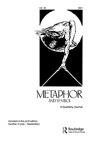Shedding Light on “Knowledge”: Identifying and Analyzing Visual Metaphors in Drawings
IF 3.3
3区 文学
0 LANGUAGE & LINGUISTICS
引用次数: 2
Abstract
ABSTRACT Drawing extends the capacity to communicate, since it allows individuals to use graphic objects and symbols to articulate complex ideas not easily communicated using words alone. Similarly, theorists argue that metaphors are commonly used to communicate complex and abstract concepts. Though, the interpretation of visual metaphors has been studied in relation to film and advertising, referencing common metaphors used in language, research has yet to examine how individuals construct their own visual metaphors and whether existing language-based metaphors are used, as a basis. Studying the underlying structure of drawings, using organizing frameworks and mapping systems, provides insight into how individuals use metaphors to communicate and the interdependent relationships between text and image. This study applies conceptual metaphor theory and frame semantics to identify and map visual metaphors in drawings of Knowledge. Three research questions guided the study: How are visual metaphors [of Knowledge] inferred in participant drawings using existing language-based metaphors?; Can language-based metaphor ontologies and semantic systems be used for interpreting visual metaphors?; and How are inferences found in language-based metaphors evident in the design of visual metaphors? Data were collected as part of the study: What does knowledge look like?, where participants (N = 404) were asked to draw what they thought Knowledge looks like to them, and explain why they drew what they did in writing. Five example cases are presented in the results: 1) the Illuminated Light Bulb, 2) the Electric Brain, 3) the Brain as a Container for Knowledge, 4) Knowledge (Ideas) as Food, and 5) the Open Mind. The findings present three notable conclusions: the combination of multiple metaphors within a single drawing; the use of a language-based metaphor ontology (i.e., Master Metaphor List) and frame semantics as analytic tools to examine visual metaphors; and the potential for additional language-based metaphor categories to emerge.透视“知识”:绘画中视觉隐喻的识别与分析
抽象绘画扩展了交流的能力,因为它允许个人使用图形对象和符号来表达复杂的想法,而这些想法不容易单独使用文字进行交流。同样,理论家们认为隐喻通常用于传达复杂和抽象的概念。尽管视觉隐喻的解释已经在电影和广告中进行了研究,参考了语言中常见的隐喻,但研究尚未检验个体如何构建自己的视觉隐喻,以及是否使用了现有的基于语言的隐喻作为基础。使用组织框架和映射系统研究绘画的基本结构,可以深入了解个人如何使用隐喻进行交流,以及文本和图像之间的相互依存关系。本研究运用概念隐喻理论和框架语义学对知识图谱中的视觉隐喻进行识别和映射。三个研究问题指导了这项研究:在参与者的绘画中,如何使用现有的基于语言的隐喻来推断[知识]的视觉隐喻?;基于语言的隐喻本体论和语义系统可以用来解释视觉隐喻吗?;在视觉隐喻的设计中,基于语言的隐喻中的推论是如何表现出来的?数据是作为研究的一部分收集的:知识是什么样子的?,参与者(N=404)被要求画出他们认为知识对他们来说是什么样子的,并解释他们为什么画出他们在写作中所做的事情。结果中给出了五个例子:1)发光灯泡,2)电脑,3)大脑是知识的容器,4)知识(思想)是食物,5)开放的思维。研究结果提出了三个显著的结论:多个隐喻在一幅画中的结合;使用基于语言的隐喻本体论(即主隐喻列表)和框架语义作为分析工具来研究视觉隐喻;以及出现更多基于语言的隐喻类别的可能性。
本文章由计算机程序翻译,如有差异,请以英文原文为准。
求助全文
约1分钟内获得全文
求助全文
来源期刊

Metaphor and Symbol
Multiple-
CiteScore
2.90
自引率
0.00%
发文量
23
期刊介绍:
Metaphor and Symbol: A Quarterly Journal is an innovative, multidisciplinary journal dedicated to the study of metaphor and other figurative devices in language (e.g., metonymy, irony) and other expressive forms (e.g., gesture and bodily actions, artworks, music, multimodal media). The journal is interested in original, empirical, and theoretical research that incorporates psychological experimental studies, linguistic and corpus linguistic studies, cross-cultural/linguistic comparisons, computational modeling, philosophical analyzes, and literary/artistic interpretations. A common theme connecting published work in the journal is the examination of the interface of figurative language and expression with cognitive, bodily, and cultural experience; hence, the journal''s international editorial board is composed of scholars and experts in the fields of psychology, linguistics, philosophy, computer science, literature, and media studies.
 求助内容:
求助内容: 应助结果提醒方式:
应助结果提醒方式:


